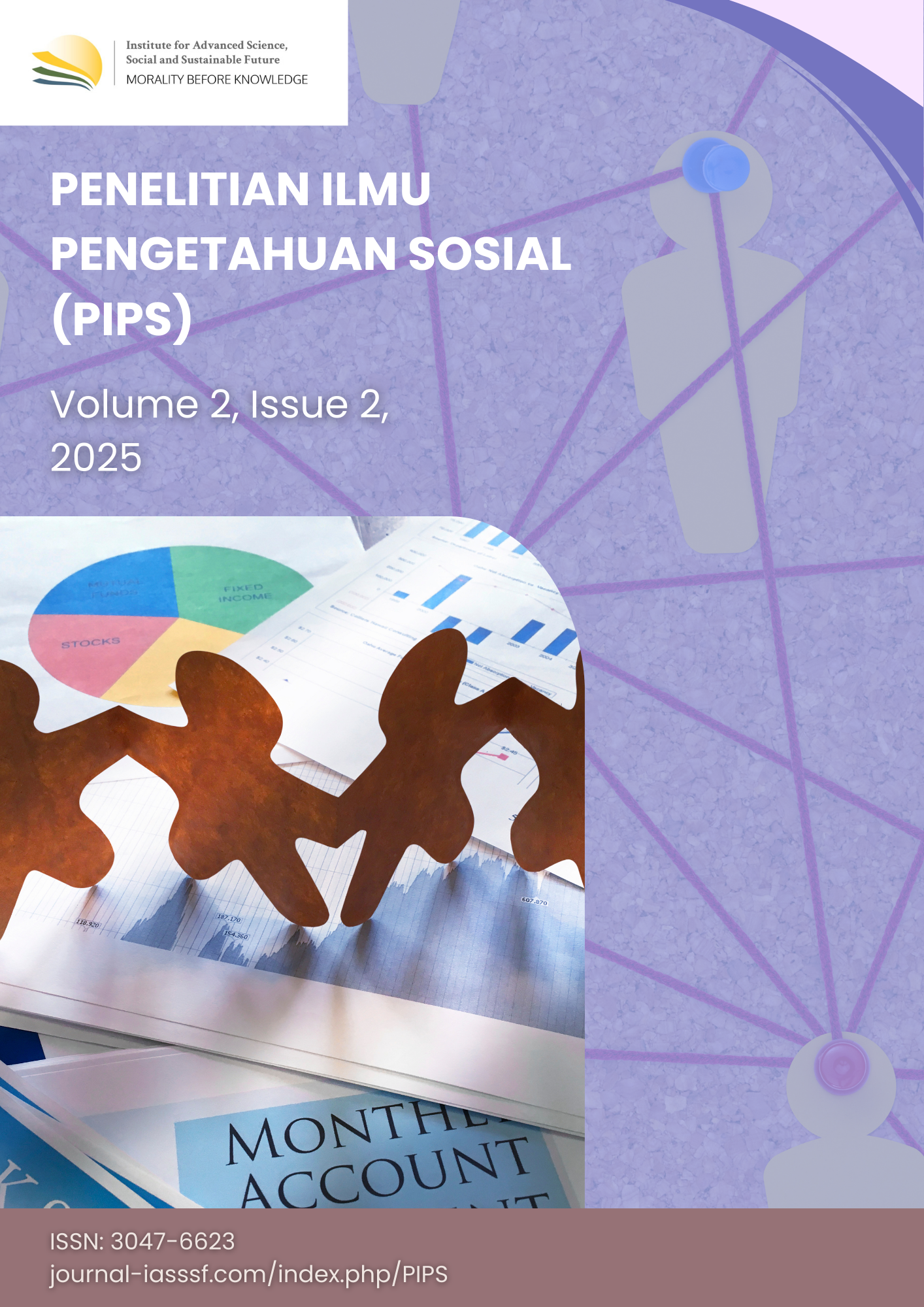Environmental education gaps: Women's mythical beliefs and perceptions of flood disasters
DOI:
https://doi.org/10.61511/pips.v2i2.2025.2303Keywords:
flood, gender perspective, womenAbstract
Background: Nationally, flood disasters have increased, which have a negative impact on all sectors of social life, especially on the daily lives of women. Methods: The research method uses a qualitative method by conducting interviews with women who live on Wonocolo Street, Jemur Wonosari Village, Wonocolo District, Surabaya, East Java from Neighborhood Flats/Rukun Tetangga (RT) and Residential Flats/Rukun Warga (RW) in the affected areas and conducting field observations and supporting literature reviews. Findings: Every year, during the rainy season, floods occur, which become an important problem in various countries. Because, many negative impacts are experienced by the community, both individually, groups and on the government system. This study aims to describe women's perceptions of flooding on Wonocolo Street, Jemur Wonosari Village, Wonocolo District, Surabaya, East Java, Indonesia about the occurrence, causes, and impacts of flooding on women as flood victims and on public awareness of the environment. Conclusion: The results of the study stated that the causes of flooding were high rainfall, houses being built too close together, careless waste disposal, lack of greenery, poor drainage and culvert construction, limited road access, limited culvert and drainage construction, limited wetlands, houses being built along rivers, and river silting. The impact of flooding is material losses in terms of buildings, income, and daily life. Novelty/Originality of this article: This study concluded that women on Wonocolo Street, Jemur Wonosari Village, Wonocolo District, Surabaya, East Java still believe in the prevailing myths and lack awareness of the importance of protecting the environment together.
References
Abderrahmane, J., & Azzeddine, C. (2024). Perception and Knowledge of Disaster Risks and Preparedness: The Case of the City of Mohammedia, Morocco, 43. https://doi.org/10.3390/iecg2022-14929
Achmad, A. (2023). Diguyur Hujan Intensitas Tinggi, Banjir di Wonocolo Tak Kunjung Surut. Berita Satu. https://www.beritasatu.com/nusantara/1041031/diguyur-hujan-intensitas-tinggi-banjir-di-wonocolo-tak-kunjung-surut
Alfian, R., Bilal, A. M. S. M., Maryto, M. S., Yusril, Y. A., Fahrudin, S., Falah, H., Bagus, W. P., & A. P. T. (2024). Kecamatan Wonocolo dalam Angka Wonocolo District In Figures 2024. BPS Kota Surabaya.
Asante, F., Guodaar, L., Nyaaba, E., & Addai, G. (2024). Gendered flood risk perception and mental health of urban households in Ghana: Insights from the Oforikrom municipality. Environmental Challenges, 15, 100921. https://doi.org/10.1016/j.envc.2024.100921
Aulia, N. P, & Anak, A. S. A. W.. (2023). Elemen Penyebab Serta Sebaran Kawasan Rawan Banjir Di Kelurahan Keputih Surabaya. Jurnal Plano Buana, 3(2), 60–67. https://doi.org/10.36456/jpb.v3i2.6990
Azad, M. J., & Pritchard, B. (2023). The importance of women’s roles in adaptive capacity and resilience to flooding in rural Bangladesh. International Journal of Disaster Risk Reduction, 90(2), 103660. https://doi.org/10.1016/j.ijdrr.2023.103660
Badan Pembinaan Hukum Nasional - Kemenkumham RI. (2011). Peraturan Pemerintah Republik Indonesia Nomor 38 Tahun 2011 Tentang Sungai. https://bphn.go.id/,
Bahana Patria Gupta. (2024). Hujan Lebat Sebabkan Banjir di Banyak Wilayah Surabaya. Kompas. https://www.kompas.id/baca/foto/2024/12/24/hujan-lebat-sebabkan-banjir-di-banyak-wilayah-surabaya
Bhutta, Z. A., Bhutta, S. Z., Raza, S., & Sheikh, A. T. (2022). Addressing the human costs and consequences of the Pakistan flood disaster. The Lancet, 400(10360), 1287–1289. https://doi.org/10.1016/S0140-6736(22)01874-8
Chen, Y., Hu, M., Chen, X., Wang, F., Liu, B., & Huo, Z. (2023). An approach of using social media data to detect the real time spatio-temporal variations of urban waterlogging. Journal of Hydrology, 625, 130128. https://doi.org/10.1016/j.jhydrol.2023.130128
Dian, K. (2020). Hujan Lebat Akibatkan Banjir di Surabaya Jelang Akhir Pekan. Liputan 6. https://www.liputan6.com/surabaya/read/4168782/hujan-lebat-akibatkan-banjir-di-surabaya-jelang-akhir-pekan
Esti, W. (2024). Saat Surabaya Dikado Banjir Terparah di Penghujung 2024. Detik.com. https://www.detik.com/jatim/berita/d-7711513/saat-surabaya-dikado-banjir-terparah-di-penghujung-2024
Ferris, E. (2020). Research on climate change and migration where are we and where are we going? Migration Studies, 8(4), 612–625. https://doi.org/10.1093/migration/mnaa028
Ginanjar, D. (2019). Data Bappeko: Wonocolo dan Karang Pilang Rawan Banjir. Jawa Pos. https://www.jawapos.com/surabaya-raya/01241432/data-bappeko-wonocolo-dan-karang-pilang-rawan-banjir
Gros, C., Bailey, M., Schwager, S., Hassan, A., Zingg, R., Uddin, M. M., & Coughlan de Perez, E. (2019). Household-level effects of providing forecast-based cash in anticipation of extreme weather events: Quasi-experimental evidence from humanitarian interventions in the 2017 floods in Bangladesh. International Journal of Disaster Risk Reduction, 41, 101275. https://doi.org/10.1016/j.ijdrr.2019.101275
Herawati, N. (2025). Tiga Anak Tewas Tenggelam di Sungai Surabaya Sepanjang 2024, Apa Langkah Pemkot?. Jawa Pos. https://www.jawapos.com/surabaya-raya/015493423/tiga-anak-tewas-tenggelam-di-sungai-surabaya-sepanjang-2024-apa-langkah-pemkot
Hu, C., Xia, J., She, D., Song, Z., Zhang, Y., & Hong, S. (2021). A new urban hydrological model considering various land covers for flood simulation. Journal of Hydrology, 603, 126833. https://doi.org/10.1016/j.jhydrol.2021.126833
Imam, W. (2022). Hujan Lebat 1 Jam, Sejumlah Wilayah di Surabaya Terendam Banjir. Detik.com. https://www.detik.com/jatim/berita/d-5977656/hujan-lebat-1-jam-sejumlah-wilayah-di-surabaya-terendam-banjir
Iqbal, A., & Nazir, H. (2023). Community perceptions of flood risks and their attributes: A case study of rural communities of Khipro, District Sanghar, Pakistan. Urban Climate, 52, 101715. https://doi.org/10.1016/j.uclim.2023.101715
Kukuh, S. W. (2024). Surabaya Dikepung Banjir, Sejumlah Titik Lumpuh. Tempo. https://www.tempo.co/politik/surabaya-dikepung-banjir-sejumlah-titik-lumpuh-1185734
Kurata, Y. B., Ong, A. K. S., Ang, R. Y. B., Angeles, J. K. F., Bornilla, B. D. C., & Fabia, J. L. P. (2023). Factors Affecting Flood Disaster Preparedness and Mitigation in Flood-Prone Areas in the Philippines: An Integration of Protection Motivation Theory and Theory of Planned Behavior. Sustainability, 15(8), 6657. https://doi.org/10.3390/su15086657
Li, B., Hou, J., Wang, X., Ma, Y., Li, D., Wang, T., & Chen, G. (2023). High-Resolution Flood Numerical Model and Dijkstra Algorithm Based Risk Avoidance Routes Planning. Water Resources Management, 37(8), 3243–3258. https://doi.org/10.1007/s11269-023-03500-5
Lim, K. Y., Zakaria, N. A., & Foo, K. Y. (2020). Water quality assessment of urban catchment after the large-scale flood event: The worst natural tragedy at Pahang River, Malaysia. Desalination and Water Treatment, 175, 32–42. https://doi.org/10.5004/dwt.2020.24790
Lisa, D., Anjal, P., Zinta, Z., Farid, A., Nuvodita, S., Sara, D. W., Johanna, N., Meaghan, D., & K. B. (2019). Is adaptation success a flawed concept? Nature Climate Change, 9(8), 572–574. https://doi.org/10.1038/s41558-019-0539-0
Liu, J., Feng, S., Gu, X., Zhang, Y., Beck, H. E., Zhang, J., & Yan, S. (2022). Global changes in floods and their drivers. Journal of Hydrology, 614, 128553. https://doi.org/10.1016/j.jhydrol.2022.128553
Liu, Q., Yuan, J., Yan, W., Liang, W., Liu, M., & Liu, J. (2023). Association of natural flood disasters with infectious diseases in 168 countries and territories from 1990 to 2019: A worldwide observational study. Global Transitions, 5, 149–159. https://doi.org/10.1016/j.glt.2023.09.001
Liu, W., Feng, Q., Engel, B. A., Yu, T., Zhang, X., & Qian, Y. (2023). A probabilistic assessment of urban flood risk and impacts of future climate change. Journal of Hydrology, 618, 129267. https://doi.org/10.1016/j.jhydrol.2023.129267
Michael, A., & Dixon, R. (2019). Audit data analytics of unregulated voluntary disclosures and auditing expectations gap. International Journal of Disclosure and Governance, 16(4), 188–205. https://doi.org/10.1057/s41310-019-00065-x
Mostafizur, R. M., Alam, S. I., Tanvir, H. M., & Tasnim, F. (2023). Impact of Disaster on mental health of women: A case study on 2022 flash flood in Bangladesh. International Journal of Disaster Risk Reduction, 96(4), 103935. https://doi.org/10.1016/j.ijdrr.2023.103935
Munawar, H. S., Mojtahedi, M., Hammad, A. W. A., Kouzani, A., & Mahmud, M. A. P. (2022). Disruptive technologies as a solution for disaster risk management: A review. Science of The Total Environment, 806, 151351. https://doi.org/10.1016/j.scitotenv.2021.151351
Nakiyemba, A., Zakaria, K., Mosses, K., Immeldah, N., & Sowedi, M. (2025). Women’s knowledge and perception of flood disasters in Butaleja District, Uganda. Progress in Disaster Science, 25(12), 100399. https://doi.org/10.1016/j.pdisas.2024.100399
Nazeer, M., & Bork, H. R. (2021). A local scale flood vulnerability assessment in the flood-prone area of Khyber Pakhtunkhwa, Pakistan. Natural Hazards, 105(1), 755–781. https://doi.org/10.1007/s11069-020-04336-7
Nifa, F. A. A., Lin, C. K., Rani, W. N. M. W. M., & Wei, O. J. (2018). A study on awareness of disaster risk reduction (DRR) among university students: The case of PETRONAS residential hall students. 020005. https://doi.org/10.1063/1.5055407
Notten, P., Gower, A., & Lewis, Y. (2021). Single-use menstrual products and their alternatives: Recommendations from Life Cycle Assessments. United Nation Environment Programme. https://www.lifecycleinitiative.org/wp-content/uploads/2021/07/UNEP-LCI-Single-use-vs-reusable-Menstrual-Products-Meta-study.pdf
Otto, F. E. L., Zachariah, M., Saeed, F., Siddiqi, A., Kamil, S., Mushtaq, H., & Clarke, B. (2023). Climate change increased extreme monsoon rainfall, flooding highly vulnerable communities in Pakistan. Environmental Research: Climate, 2(2), 025001. https://doi.org/10.1088/2752-5295/acbfd5
Padulano, R., Costabile, P., Costanzo, C., Rianna, G., Del Giudice, G., & Mercogliano, P. (2021). Using the present to estimate the future: A simplified approach for the quantification of climate change effects on urban flooding by scenario analysis. Hydrological Processes, 35(12). https://doi.org/10.1002/hyp.14436
Parhizkar, H., Taddei, P., Weziak-bialowolska, D., Mcneely, E., Spengler, D., Guillermo, J., & Laurent, C. (2023). Flood Occurrences And Characteristics In Poland (Central Europe) In The Last Millennium. Building and Environment, 110984. https://doi.org/10.1016/j.gloplacha.2025.104706
Pishghadam, R., & Abbasnejad, H. (2017). Introducing Emotioncy as an Invisible Force Controlling Causal Decisions: A Case of Attribution Theory. Polish Psychological Bulletin, 48(1), 129–140. https://doi.org/10.1515/ppb-2017-0016
Płotka-Wasylka, J., Makoś-Chełstowska, P., Kurowska-Susdorf, A., Treviño, M. J. S., Guzmán, S. Z., Mostafa, H., & Cordella, M. (2022). End-of-life management of single-use baby diapers: Analysis of technical, health and environment aspects. Science of the Total Environment, 836(3). https://doi.org/10.1016/j.scitotenv.2022.155339
Rahman, F., Shampa, Murshed, S. B., Salehin, M., Sakib, F. M., & de Perez, E. C. (2024). Does forecast-based financing (FbF) lower women’s vulnerability to flooding? Progress in Disaster Science, 24(5), 100389. https://doi.org/10.1016/j.pdisas.2024.100389
Risky, D. P. (2021). Hujan Deras Banjiri Kampung Wonocolo, Warga Diimbau Tak Buang Sampah ke Sungai. Faktual News. https://faktualnews.co/2021/12/12/hujan-deras-banjiri-kampung-wonocolo-warga-diimbau-tak-buang-sampah-ke-sungai/294419/
Santana, T. C., Guiselini, C., Cavalcanti, S. D. L., Silva, M. V. da, Vigoderis, R. B., Santos Júnior, J. A., & Jardim, A. M. da R. F. (2022). Quality of rainwater drained by a green roof in the metropolitan region of Recife, Brazil. Journal of Water Process Engineering, 49, 102953. https://doi.org/10.1016/j.jwpe.2022.102953
Singh, R. K., Zander, K. K., Kumar, S., Singh, A., Sheoran, P., Kumar, A., & Garnett, S. T. (2017). Perceptions of climate variability and livelihood adaptations relating to gender and wealth among the Adi community of the Eastern Indian Himalayas. Applied Geography, 86, 41–52. https://doi.org/10.1016/j.apgeog.2017.06.018
Siti, A. N. H., Dwi, A., Oktavia, N., & Intan, N. (2024). Teori Tentang Persepsi dan Teori Atribusi Kelley. CiDEA Journal, 3(1), 44–54. https://doi.org/10.56444/cideajournal.v3i1.1810
Sundah, B. W. (2017). Ternyata Inilah yang Jadi Penyebab Banjir di Kawasan Wonocolo, Surabaya. Jatim Tribune News.
Tellman, B., Lall, U., Islam, A. K. M. S., & Bhuyan, M. A. (2022). Regional Index Insurance Using Satellite-Based Fractional Flooded Area. Earth’s Future, 10(3). https://doi.org/10.1029/2021EF002418
Toppenberg-Pejcic, D., Noyes, J., Allen, T., Alexander, N., Vanderford, M., & Gamhewage, G. (2019). Emergency Risk Communication: Lessons Learned from a Rapid Review of Recent Gray Literature on Ebola, Zika, and Yellow Fever. Health Communication, 34(4), 437–455. https://doi.org/10.1080/10410236.2017.1405488
Tozier de la Poterie, A., Castro, E., Rahaman, H., Heinrich, D., Clatworthy, Y., & Mundorega, L. (2023). Anticipatory action to manage climate risks: Lessons from the Red Cross Red Crescent in Southern Africa, Bangladesh, and beyond. Climate Risk Management, 39, 100476. https://doi.org/10.1016/j.crm.2023.100476
Udo, F., & Naidu, M. (2023). Exploring Black African women’s experiences of vulnerability and adaptation to flood impacts in the eThekwini metropolitan municipality, KwaZulu-Natal, South Africa. International Journal of Disaster Risk Reduction, 93(6), 103798. https://doi.org/10.1016/j.ijdrr.2023.103798
Udo, F., & Naidu, M. (2024). Assessing local government’s response to black women’s vulnerability and adaptation to the impacts of floods in the context of intersectionality: The case of eThekwini metropolitan municipality, South Africa. Environmental Policy and Governance, 34(1), 31–41. https://doi.org/10.1002/eet.2053
Ullah, W., Haijun, D., Shah, A. A., Alotaibi, B. A., & Rauf, A. (2024). Behind the floodwaters: Violence against women, and disaster management capacities in flood-affected areas of Pakistan. Climate Risk Management, 46(5), 100653. https://doi.org/10.1016/j.crm.2024.100653
Velasco Perez, M., Sotelo Navarro, P. X., Vazquez Morillas, A., Espinosa Valdemar, R. M., & Hermoso Lopez Araiza, J. P. (2021). Waste management and environmental impact of absorbent hygiene products: A review. Waste Management & Research: The Journal for a Sustainable Circular Economy, 39(6), 767–783. https://doi.org/10.1177/0734242X20954271
Wahyudiyanta, I. (2017). Mahasiswi UIN Sunan Ampel Tewas Tersetrum saat Banjir. Detik.com. https://news.detik.com/berita-jawa-timur/d-3741692/mahasiswi-uin-sunan-ampel-tewas-tersetrum-saat-banjir
Yang, J. (2024). Waste accumulation in Jakarta’s slums: Neoliberal flows of waste distribution. Geoforum, 150(5), 103994. https://doi.org/10.1016/j.geoforum.2024.103994
Yang, J., Ahn, D., Bahk, J., Park, S., Rizqihandari, N., & Cha, M. (2024). Automatic assessment of climate risk using satellite imagery: A case study of Jakarta. Climate Risk Management, 46(6), 100651. https://doi.org/10.1016/j.crm.2024.100651
Zenghe, H. X. D. (2024). When the Levee Breaks: The Impact of Floods on Educational Outcomes in China. European Journal of Oncology Nursing, 102572. https://doi.org/10.1016/j.jdeveco.2025.103450
Downloads
Published
How to Cite
Issue
Section
License
Copyright (c) 2025 Abu Aman

This work is licensed under a Creative Commons Attribution 4.0 International License.














